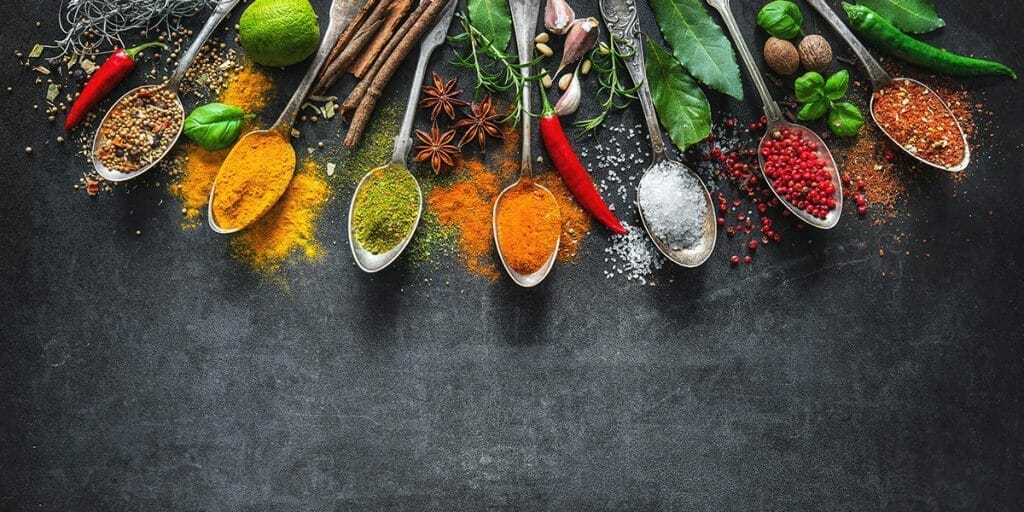 Turmeric is obtained from the dried Curcumin longa L. (ginger family) and is well recognised as a curry spice. Curcumin is widely consumed as a food ingredient and has a long history as a spice with medicinal purposes in China and Southeast Asia. Turmeric is comprised of 3 curcuminoids (curcumin, demethoxycurcumin and bisdemethoxycurcumin), sugars, proteins, volatile oils (natlantone, tumerone and zingiberone) and resins. Of the 3 curcuminoids, curcumin is the most active lipophilic polyphenol compound which is quite stable in the acidic pH of the stomach.
Turmeric is obtained from the dried Curcumin longa L. (ginger family) and is well recognised as a curry spice. Curcumin is widely consumed as a food ingredient and has a long history as a spice with medicinal purposes in China and Southeast Asia. Turmeric is comprised of 3 curcuminoids (curcumin, demethoxycurcumin and bisdemethoxycurcumin), sugars, proteins, volatile oils (natlantone, tumerone and zingiberone) and resins. Of the 3 curcuminoids, curcumin is the most active lipophilic polyphenol compound which is quite stable in the acidic pH of the stomach.
Curcumin (diferuloylmethane), is a highly pleiotropic molecule that was first shown to exhibit antibacterial activity in 1949. Since then, extensive clinical studies have shown that this polyphenol exerts anti‐inflammatory, anticancer, hypoglycaemic, antioxidant, wound‐healing, antiviral, and antimicrobial activities, indicating curcumin’s therapeutic potential against a wide range of human diseases. In addition, curcumin has been shown to directly interact with numerous cell signalling molecules, as well as targets involved in inflammation, cancer, and other diseases. It has also been observed that curcumin can modulate the activity of various important transcription factors, growth factors, inflammatory cytokines, protein kinase, and other enzymes. These activities of curcumin can lead to several biological effects, including the inhibition of free radicals’ production, oxidative stress reduction, and inhibition of the transcription of genes implicated in oxidative stress and inflammatory responses. In effect its wide range of activities offers numerous opportunities for its use in human health.
 Some promising effects have been observed in patients with obesity, metabolic syndrome, NAFLD and diabetes, as well as different types of cancer, depression, arthritis, skin diseases, inflammatory bowel disease, muscle lesions, premenstrual syndrome symptoms, gynaecological diseases, and inflammation.
Some promising effects have been observed in patients with obesity, metabolic syndrome, NAFLD and diabetes, as well as different types of cancer, depression, arthritis, skin diseases, inflammatory bowel disease, muscle lesions, premenstrual syndrome symptoms, gynaecological diseases, and inflammation.
However, pharmacokinetic and bioavailability studies have observed that curcumin is poorly absorbed and rapidly metabolised and excreted from the body, limiting its clinical use. Hence, its bioavailability needs to be optimised in order to be utilised properly and efficiently in the human body and to allow its mechanistic effects to impart health benefits. However, one pathway that is less dependent on absorption is its role in improving gut barrier function.[1] Curcumin appears to be able to improve barrier function and so reduce LPS migration and may represent a first point of contact opportunity for overall inflammation reduction.
Its role in joint discomfort either as an individual ingredient or in conjunction with other nutrients is also attracting attention. The prevalence of osteoarthritis (OA) of the knee, hip, and hand has been estimated at 20% to 30% in the adult population. Knee OA is the most common form; its prevalence increases throughout the lifespan. Globally, knee and hip OA were estimated to be the 11th greatest contributors to years of life lived with disability in 2010. Overall, currently available long-term pharmacotherapeutic treatments available to those with OA offer limited therapeutic benefit, potentially increasing the disease’s negative impact. The pathophysiology of the cartilage degradation central to developing OA is multi-factorial but related to the presence of pro-inflammatory cytokines and oxidative stress, which can be exacerbated by the presence of metabolic comorbidities (e.g., obesity, diabetes). Notably, ‘inflammaging’, a chronic low-grade inflammation associated with aging, is the result of a disparity between pro- and anti-inflammatory processes and has been linked to age-related chronic conditions, including OA. Mechanisms that Curcumin has been demonstrated to beneficially alter, yet its application to demonstrate effective pain relief in OA is poorly supported by research to date. However, a meta-analysis by Sahebkar showed that when absorption was increased then a positive effect on its analgesic qualities in OA were noted.[2] Curcumin, is a plant extract that have promising pre-clinical and clinical trial data indicating its potential to reduce OA-related pain and functional disability. Additional clinical trials with these ingredients (individually or in combination) are necessary to more fully establish their usefulness but as they are very low risk, with multiple modes of action a period of experimentation carries no risk and potential benefit.
- Wang J, Ghosh SS, Ghosh S. Curcumin improves intestinal barrier function: modulation of intracellular signaling, and organization of tight junctions. Am J Physiol Cell Physiol. 2017 Apr 1;312(4):C438-C445.
- Sahebkar A, Henrotin Y. Analgesic efficacy and safety of curcumi-noids in clinical practice: a systematic review and meta-analysis of randomized controlled trials. Pain Med. 2016;17:1192–202.
